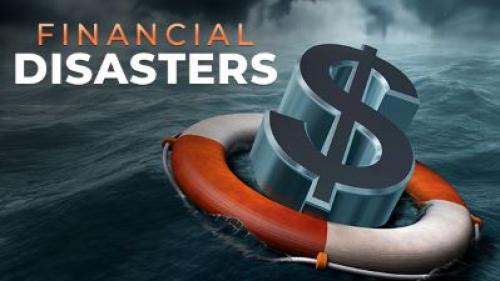TheGreatCoursesPlus - Crashes and Crises: Lessons from a History of Financial Disasters
Learn the lessons of history’s greatest financial scams and disasters. An award-winning economist shows that forewarned is forearmed.
1: Fintech, Crypto, and the Future of Disaster
- Professor Fullenkamp begins the course with the enormous influence of technology on today’s investing, which brings with it a frightening potential for crashes and crises. Cover the Flash Crash of 2010—a dip in the market that was hugely amplified by programmed trading. Then, delve into the phenomenon of cryptocurrencies such as Bitcoin, which rely on an innovation called blockchain technology.
2: The Con Men Charles Ponzi and Ivar Kreuger
- Investigate two of the most notorious con men who ever lived: Charles Ponzi, after whom the Ponzi scheme is named, and “Match King” Ivar Kreuger, who employed an elaborate variant of Ponzi’s swindle. Analyze the three ingredients that most Ponzi schemes share. Above all, learn to identify and be wary of investments that are too good to be true.
3: A Boom in Busts
- Contrast the freewheeling financial market of today with the staid system of the immediate post-World War II era. Were financial markets more stable in the past than they are now? How did the present system evolve? What type of market is normal: the steady and predictable kind or the chaotic and sometimes destructive one? In answering these questions, discover why we live in an era of busts.
4: The Tulip Bubble
- The 17th-century tulip bubble is a classic case of futures trading run amok. But how much did tulip mania resemble today’s speculative markets, as opposed to ordinary gambling? Learn the truth behind this notorious financial bubble, while reflecting on the problem of deciding a fair price for an asset, such as tulip bulbs. Also, consider how bubbles start and end.
5: The South Sea Bubble
- Relive the “Wild West” days of the British stock market in the early 18th century, when a financially-strapped government and a public craze for investing created ideal conditions for one of history’s most brazen stock manipulators. Trace John Blunt’s use of the South Sea Company—and bribery—to generate a stock-buying frenzy, making him fabulously rich—until the bubble inevitably burst.
6: The Mississippi Bubble
- Delve into the details of the Mississippi bubble, an early 18th-century financial crisis sparked by speculation in the anticipated wealth of French Louisiana. Learn how the bubble’s instigator, John Law, a Scottish gambler and convicted murderer, gained control of the French economy and pushed ideas that were ahead of their time—so far ahead that they plunged France into economic collapse.
7: Holes in the Ground: Mining Stock Frauds
- Mining companies were the internet start-ups of the 19th and early 20th centuries, offering a chance to strike it rich—or, more likely, go broke. Focus on the swindling strategy of George Graham Rice, who earned a fortune (and several prison terms) by manipulating mining stock. Discover that Mark Twain and future president Herbert Hoover both had close brushes with shady mining ventures.
8: The Panic of 1907
- Until 1920, panics were a recurring feature of economic life in the United States. What caused them and how were they cured? Investigate the Panic of 1907 and the part played by legendary banker J. P. Morgan in stemming a threatened wave of bank failures. The gold standard was an obstacle to managing panics, and the Federal Reserve System, established in 1913, proved to be a powerful antidote.
9: Hyperinflation in Germany and Zimbabwe
- Plunge into the economic nightmare of hyperinflation, learning how it happens, when it ends, and the policies that put nations at risk. The classic case of hyperinflation is post-World War I Germany, which faced a multitude of demands on a financial system already crippled by the war. Also, analyze the mistakes that sparked hyperinflation in Zimbabwe in the early 2000s.
10: The Crash of 1929
- Dissect the notorious Wall Street crash of 1929, starting with the economic conditions that led to a feverish speculative boom during the “Roaring ’20s.” Survey investment practices of the day, some of which are now outlawed. Trace the rise in stock prices into the fall of 1929, when a normal market correction seemed underway. Probe explanations for why it suddenly turned into a crash.
11: The Great Contraction of 1931–1933
- In a financial disaster called the Great Contraction, one-third of all banks in the United States failed between 1931 and early 1933. Examine the causes of this collapse in confidence, which also affected building and loan associations, made famous in the movie It’s a Wonderful Life. Appraise government attempts to stem the crisis, which led to legislation including the Glass-Steagall Act of 1933.
12: The Savings and Loan Crisis
- Wade into the quagmire that trapped savings and loan institutions in the 1980s and ’90s. Once a thriving, low-profit source of home mortgages, the industry fell victim to a combination of high interest rates, well-intentioned government deregulation, and a wave of predatory, unscrupulous managers. The ensuing debacle left the American taxpayer with a bill of $160 billion in 1995 dollars.
13: The Crash of 1987
- Meet a modern-day Frankenstein’s monster, a human creation on the loose— in this case, computerized trading. Discover how the rage for portfolio insurance controlled by computer algorithms, combined with a rapidly rising market and skittish investors, sparked the Black Monday crash of October 19, 1987, during which the Dow Jones index lost 23 percent of its value.
14: Japan’s Lost Decade
- In the 1980s, the Japanese economy seemed unstoppable. Then, it came to a screeching halt, miring the nation in more than two decades of economic stagnation. What went wrong? Analyze Japan’s postwar brand of capitalism, focusing on how its regulatory, political, and banking systems created a “bubble economy”—until the global economy and regulatory climate abruptly changed and the bubble burst.
15: Bankers Trust Swaps
- Learn the ropes for interest rate swaps, the most popular financial derivative in the world. Then, see how a complex form of swaps, brokered by Bankers Trust in the early 1990s, led to huge losses for some famous corporations and an ensuing round of bitter lawsuits. The case holds lessons for anyone investing in financial instruments that they don’t fully understand.
16: Asia, Greece, and Global Contagion
- Analyze the cause of currency crises, using the 1997 collapse of the Thai baht as test case. Uncover why such events can happen suddenly with little chance for a government to stop the precipitous fall in its currency’s value, and also why the U.S. dollar is not immune. Consider the role of currency speculators, such as George Soros, who famously broke the Bank of England in 1992.
17: The Orange County, California, Bankruptcy
- Discover how an elected official with a self-admitted seventh-grade proficiency in math earned fabulous returns as treasurer of Orange County, California, and then plunged the system into the largest municipal default in United States history up to that time. His strategy—and downfall—relied on two financial instruments: repurchase agreements and inverse floater bonds. Track down where he went wrong.
18: The Dotcom Bubble
- The rise of the internet in the 1990s spawned companies that existed only online; had never earned a profit; had no rational business plan; and, yet, generated enormous enthusiasm in their initial stock offerings. Learn why the market ignored time-tested standards and suffered the inevitable crash. Focus on the role of intangible assets in the dotcom boom and its aftermath.
19: Rogue Traders at SocGen and Barings
- Test Professor Fullenkamp’s theory that all rogue traders are the same by studying two infamous insiders: Jerome Kerviel, who cost the French bank Societe Generale more than $6 billion, and Nick Leeson, whose errant trading bankrupted Baring Brothers. Find out how trading firms are organized, and pinpoint the Achilles heel that allowed both men to go rogue.
20: Unhedged! Long-Term Capital Management
- Long-Term Capital Management was a hedge fund with everything going for it: well-heeled investors, a dream team of economists and managers, and banks willing to loan hundreds of millions of dollars with no questions asked. In 1998, it all went terribly wrong in a debacle that threatened to take down Wall Street. Spotlight the basic rules of finance that were ignored by LTCM and its banks.
21: The London Whale and Value at Risk
- Explore a risk-management tool called value at risk, or VaR. Developed by economists at J. P. Morgan in the 1990s, VaR estimates the largest loss that a given investment strategy can be expected to sustain under normal market conditions. Chart the successes of this model—and its spectacular failure in an incident involving a high-rolling trader nicknamed the “London Whale.”
22: The Goldilocks Economy and Three Bads
- In the 1990s and early 2000s, the U.S. economy was enjoying a long spell of economic growth that struck economists as just right. But that was before the “three bads” surfaced: bad monetary policy, bad private-sector behavior, and bad financial regulations. See how self-interest and overconfidence blinded investors, borrowers, and regulators to the financial crisis that exploded in 2007–2008.
23: Subprime Debt and the Run on Wall Street
- Inspect the unprecedented run on the international financial system in 2007–2008, which led to the worst recession since the Great Depression. Learn the ins and outs of subprime mortgages, collateralized debt obligations, and structured investment vehicles, which fueled a U.S. housing-construction boom that involved most of the world’s major financial institutions.
24: China’s Shadow Banks
- China was largely unaffected by the 2007–2009 global economic meltdown. But that doesn’t mean it’s immune to crises. Focus on China’s shadow banking, which is the provision of banking services by non-bank institutions. The practice is not as sinister as it sounds, but it is subject to abuse. In China’s case, the widespread use of shadow banking courts trouble that could lead to financial disaster.

Crashes.and.Crises.Lessons.from.a.History.of.Financial.Disasters.part1.GC.rar
Crashes.and.Crises.Lessons.from.a.History.of.Financial.Disasters.part2.GC.rar
Crashes.and.Crises.Lessons.from.a.History.of.Financial.Disasters.part3.GC.rar

































